

Maj.Dean Neely is in the forward, lower cockpit of the Lockeed U-2ST, a two-place version of the U-2S, a high-altitude reconnaissance aircraft that the Air Force calls "Dragon Lady."
 His voice on the intercom breaks the silence, "Do you know that you're the highest person in the world?" He explains that I am in the higher of the two cockpits and there are no other U-2's airborne right now. "Astronauts don't count." he says, "They're out of this world."
His voice on the intercom breaks the silence, "Do you know that you're the highest person in the world?" He explains that I am in the higher of the two cockpits and there are no other U-2's airborne right now. "Astronauts don't count." he says, "They're out of this world."We are above 70,000 feet and still climbing slowly as the aircraft becomes lighter. The throttle has been at its mechanical limit since takeoff, and the single General Electric F118-GE-101 turbofan engine sips fuel so slowly at this altitude that consumption is less than when idling on the ground. Although true airspeed is that of a typical jetliner, indicated airspeed registers only in double digits.
I cannot detect the curvature of the Earth, although some U-2 pilots claim that they can. The sky at the horizon is hazy white but transitions to midnight blue at our zenith. It seems that if we were much higher, the sky would become black enough to see stars at noon. The Sierra Nevada, the mountainous spine of California, has lost its glory, a mere corregation on the Earth. Lake Tahoe looks like a fishing hole, and rivers have become rivulets. Far below, "high flying" jetliners etch contrails over Reno, Nevada, but we are so high above these aircraft that they cannot be seen.
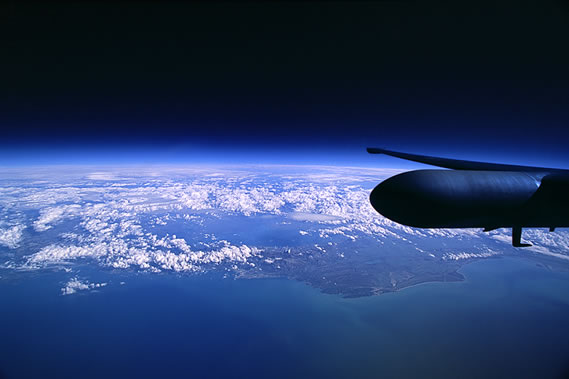
I feel a mild concern about the bailout light on the instrument panel and pray that Neely does not have reason to turn it on. At this altitude I also feel a sense of insignificance and isolation; earthly concerns seem trivial. This flight is an epiphany, a life-altering experience.
I cannot detect air noise through the helmet of my pressure suit. I hear only my own breathing, the hum of the avionics through my headset and, inexplicably, an ocasional, shallow moan from the engine, as if it were gasping for air. Atmospheric pressure is only an inch of mercury, less than 4 percent of sea level pressure. Air density and engine power are similarly low. The stratosphereic wind is predicitabily light, from the southwest at 5 kt, and the outside air temperature is minus 61 degrees Celsius.
Neely says that he has never experienced weather that could not be topped in the U-2, and I am reminded of the clasic transmission made by John Glenn during earth orbit in a Mercury space capsule: "Another thousand feet, and we'll be on top."
 Although not required, we remain in contact with Oakland Center while in Class E airspace that begins at Flight Level 600. The U-2's Mode C transponder, however, can indicate no higher than Fl600. When other U-2s are in the area, pilots report their altitudes, and ATC keeps them separted by 5000 feet and 10 miles.
Although not required, we remain in contact with Oakland Center while in Class E airspace that begins at Flight Level 600. The U-2's Mode C transponder, however, can indicate no higher than Fl600. When other U-2s are in the area, pilots report their altitudes, and ATC keeps them separted by 5000 feet and 10 miles.
Our high-flying quarters are pressurized to 29,000 feet, but 100-percent oxygen supplied only to our faces lowers our physiological altitude to about 8000 feet. A pressurization-system failure would cause our suits to instantly inflate to maintain a pressure altitude of 35,000 feet, and the flow of pure oxygen would provide a physiological altitude of 10,000 feet.
The forward and aft cockpits are configured almost identically. A significant difference is the down-looking
periscope/drift-meter in the center of the forward instrument panel. It is used to precisely track over specific ground points during reconnaissance, something that otherwise would be impossible from high altitude. The forward cockpit also is equipped with a small side-view mirror extending into the air stream. It is used to determine if the U-2 is generating a telltale contrail when over hostile territory.
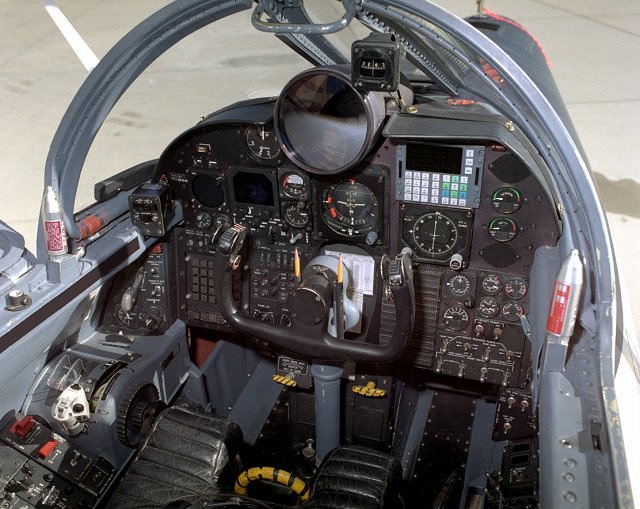
Considering its 103-foot wingspan and resultant roll dampening, the U-2 maneuvers surprisingly well at altitude; the controls are light and nicely harmonized. Control wheels (not sticks) are used, however, perhaps because aileron forces are heavy at low altitude. A yaw string (like those used on sailplanes) above each canopy silently admonishes those who allow the aircraft to slip or skid when maneuvering. The U-2 is very much a stick-and-rudder airplane, and I discover that slipping can be avoided by leading turn entry and recovery with slight rudder pressure.
When approaching its service ceiling, the U-2's maximum speed is little more than its minimum. This marginal difference between the onset of stall buffet and Mach buffet is known as coffin corner, an area warranting caution. A stall/spin sequence can cause control loss from which recovery might not be possible when so high, and an excessive Mach number can compromise structural integrity. Thankfully, an autopilot with Mach hold is provided.
The U-2 has a fuel capacity of 2,915 gallons of thermally stable jet fuel distributed among four wing tanks. It is unusual to discuss turbine fuel in gallons instead of pounds, but the 1950s-style fuel gauges in the U-2 indicate in gallons. Most of the other flight instruments seem equally antiquated.
Preparation for my high flight began the day before at Beale Air Force Base ( a.k.a. The Ranch), which is north of
After passing a physical exam (whew!), I took a short, intensive course in high-altitude physiology and use of the pressure suit. The 27-pound Model S1034 "pilot's protective assembly" is the same as the one used by astronauts during shuttle launch and reentry.
After being measured for my $150,000 spacesuit, I spent an hour in the egress trainer. It provided no comfort to learn that pulling up mightily on the handle between my legs would activate the ejection seat at any altitude or airspeed. When the handle is pulled, the control wheels go fully forward, explosives dispose of the canopy, cables attached to spurs on your boots pull your feet aft, and you are rocketed into space. You could then free fall in your inflated pressure suit for 54,000 feet or more. I was told that "the parachute opens automatically at 16,500 feet, or you get a refund."
I later donned a harness and virtual-reality goggles to practice steering a parachute to landing. After lunch, a crew assisted me into a pressure suit in preparation for my visit to the altitude chamber. There I became reacquainted with the effects of hypoxia and was subjected to a sudden decompression that elevated the chamber to 73,000 feet. The pressure suit inflated as advertised and just as suddenly I became the Michelin man. I was told that it is possible to fly the U-2 while puffed up but that it is difficult.
A beaker of water in the chamber boiled furiously to demonstrate what would happen to my blood if I were exposed without protection to ambient pressure above 63,000 feet.
After a thorough preflight briefing the next morning, Neeley and I put on long johns and UCDs (urinary collection devices), were assisted into our pressure suits, performed a leak check (both kinds), and settled into a pair of reclining lounge chairs for an hour of breathing pure oxygen. This displaces nitrogen in the blood to prevent decompression sickness (the bends) that could occur during ascent.
During this "pre-breathing," I felt as though I were in a Ziploc bag-style cocoon and anticipated the possibility of claustrophobia. There was none, and I soon became comfortably acclimatized to my confinement.
We were in the aircraft an hour later. Preflight checks completed and engine started, we taxied to Beale's 12,000-foot-long runway. The single main landing gear is not steerable, differential braking is unavailable, and the dual tail wheels move only 6 degrees in each direction, so it takes a lot of concrete to maneuver on the ground. Turn radius is 189 feet, and I had to lead with full rudder in anticipation of all turns.
We taxied into position and came to a halt so that personnel could remove the safety pins from the outrigger wheels (called pogos) that prevent one wing tip or the other from scraping the ground. Lt. Col. Greg "Spanky" Barber, another U-2 pilot, circled the aircraft in a mobile command vehicle to give the aircraft a final exterior check.
I knew that the U-2 is overpowered at sea level. It has to be for its engine, normally aspirated like every other turbine engine, to have enough power remaining to climb above 70,000 feet. Also, we weighed only 24,000 pounds (maximum allowable is 41,000 pounds) and were departing into a brisk headwind. Such knowledge did not prepare me for what followed.
The throttle was fully advanced and would remain that way until the beginning of descent. The 17,000 pounds of thrust made it feel as though I had been shot from a cannon. Within two to three seconds and 400 feet of takeoff roll, the wings flexed, the pogos fell away, and we entered a nose-up attitude of almost 45 degrees at a best-angle-of-climb airspeed of 100 kts. Initial climb rate was 9,000 fpm.
We were still over the runway and through 10,000 feet less than 90 seconds from brake release. One need not worry about a flame out after takeoff in a U-2. There either is enough runway to land straight ahead or enough altitude (only 1,000 feet is needed) to circle the airport for a dead-stick approach and landing.
The bicycle landing gear creates little drag and has no limiting air-speed, so there was no rush to tuck away the wheels. (The landing gear is not retracted at all when in the traffic pattern shooting touch and goes).
We passed through 30,000 feet five minutes after liftoff and climb rate steadily decreased until above 70,000 feet, when further climb occurred only as the result of fuel burn.
Dragon Lady is still drifting toward the upper limits of the atmosphere at 100 to 200 fpm and will continue to do so until it is time to descend. It spends little of its life at a given altitude. Descent begins by retarding the throttle to idle and lowering the landing gear. We raise the spoilers, deploy the speed brakes (one on each side of the aft fuselage), and engage the gust alleviation system. This raises both ailerons 7.5 degrees above their normal neutral point and deflects the wing flaps 6.5 degrees upward. This helps to unload the wings and protect the airframe during possible turbulence in the lower atmosphere.
Gust protection is needed because the Dragon Lady is like a
With everything possible hanging and extended, the U-2 shows little desire to go down. It will take 40 minutes to descend to traffic pattern altitude but we needed only half that time climbing to altitude. During this normal descent, the U-2 covers 37 nm for each 10,000 of altitude lost. When clean and at the best glide speed of 109 kts, it has a glide ratio of 28:1. It is difficult to imagine ever being beyond glide range of a suitable airport except when over large bodies of water or hostile territory. Because there is only one fuel quantity gauge, and it shows only the total remaining, it is difficult to know whether fuel is distributed evenly, which is important when landing a U-2. A low-altitude stall is performed to determine which is the heavier wing, and some fuel is then transferred from it to the other.
We are on final approach with flaps at 35 degrees (maximum is 50 degrees) in a slightly nose-down attitude. The U-2 is flown with a heavy hand when slow, while being careful not to overcontrol. Speed over the threshold is only 1.1 VSO (75 kts), very close to stall. More speed would result in excessive floating.
I peripherally see Barber accelerating the 140-mph, stock Chevrolet Camaro along the runway as he joins in tight formation with our landing aircraft. I hear him on the radio calling out our height (standard practice for all U-2 landings). The U-2 must be close to normal touchdown attitude at a height of one foot before the control wheel is brought firmly aft to stall the wings and plant the tail wheels on the concrete. The feet remain active on the pedals, during which time it is necessary to work diligently to keep the wings level. A roll spoiler on each wing lends a helping hand when its respective aileron is raised more than 13 degrees.
The aircraft comes to rest, a wing tip falls to the ground, and crewmen appear to reattach the pogos for taxiing.
Landing a U-2 is notoriously challenging, especially for those who have never flown tail draggers or sailplanes. It can be like dancing with a lady or wrestling a dragon, depending on wind and runway conditions. Maximum allowable crosswind is 15 kts.
The U-2 was first flown by Tony Levier in August 1955, at Groom Lake(Area 51), Nevada. The aircraft was then known as Article 341, an attempt by the Central Intelligence Agency to disguise the secret nature of its project. Current U-2s are 40 percent larger and much more powerful than the one in which Francis Gary Powers was downed by a missile over the on May 1, 1960.
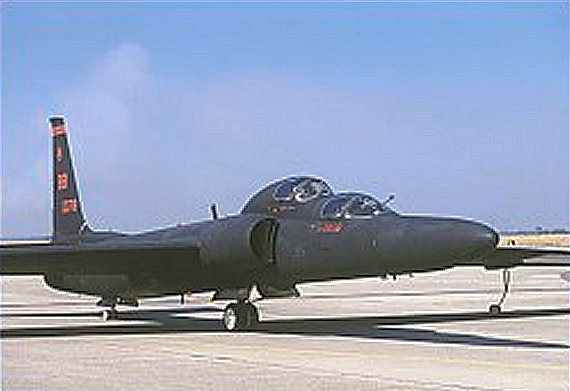
The Soviets referred to the U-2 as the "Black Lady of Espionage" because of its spy missions and mystique. The age of its design, however, belies the sophistication of the sensing technology carried within. During U.S. involvement in Kosovo, for example, U-2s gathered and forwarded data via satellite to Intelligence at Beale AFB for instant analysis. The results were sent via satellite to battle commanders, who decided whether attack aircraft should be sent to the target. In one case, U-2 sensors detected enemy aircraft parked on a dirt road and camouflaged by thick, overhanging trees. Only a few minutes elapsed between detection and destruction. No other nation has this capability.
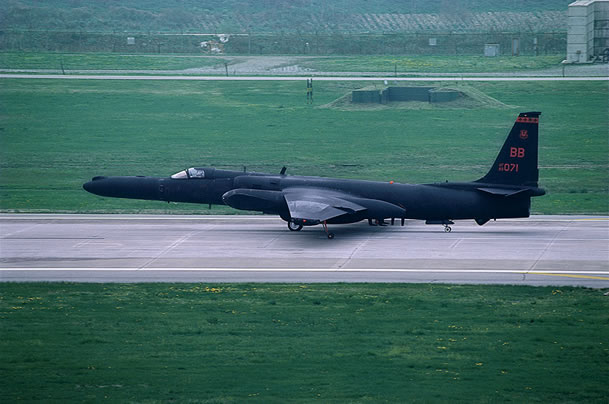
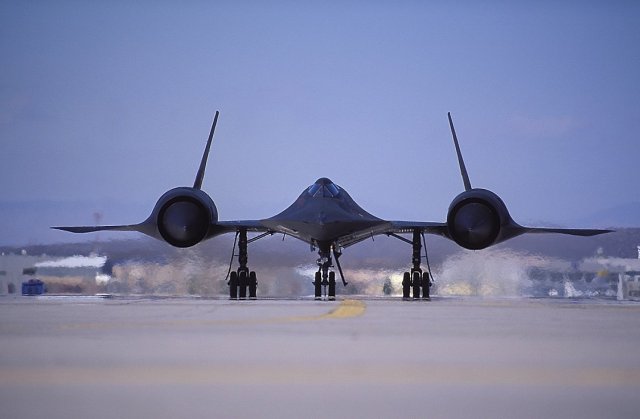
With the Libyan coast fast approaching now, Walt asks me for the third time if I think the jet wil get to the speed and altitude we want in time. I tel him yes. I know he is concerned. He is dealing with the data; that's what engineers do, and I am glad he is. But I have my hands on the stick and throttles and I can feel the heart of a thoroughbred, running now with the power and perfection she was designed to possess.I also talk to her. Like the combat veteran she is, the jet senses the target area and seems o prepare herself. For the first time in two days, the inlet door closes flush and all vibration is gone. We've become so used to the constant buzzing that the jet sounds quiet now by comparison. The Mach correspondingly increases slightly and the jet is flying in that constantly smooth and steady style we have so often seen at these speeds. We reach our target altitude and speed, with five miles to spare.
Entering the target area, in response to the jet's new found vitality, Walt says, "That's amazing..." and with my left hand pushing two throttles further forward, I think to myself that there is much they don't teach at engineering school.
Out my left window, Libya looks like a huge sandbox. A featureless brown terrain stretches all the way to the horizon. There is no sign of any activity. Then Walt tells me he is getting lots of electronic signals, and they are not the friendly kind.
The jet is performing perfectly now, flying better than she has in weeks. She seems to know where she is. She likes the high Mach, as we penetrate deeper into Libyan airspace. Leaving the footprint of our sonic boom across Benghazi, I sit motionless, with stilled hands on throttles and the pitch control, my eyes glued to the guages. Only the Mach indicator is moving, steadly increasing in hundredths, in a rh1ythmic consistancy similiar to the long distance runner who has caught his second wind and picked up the pace. The jet was made for this kind of performance and she wasn't about to let an errant inlet door make her miss the show. With the power of forty locomotives, we puncture the quiet African sky and continue further south across the bleak landscape.
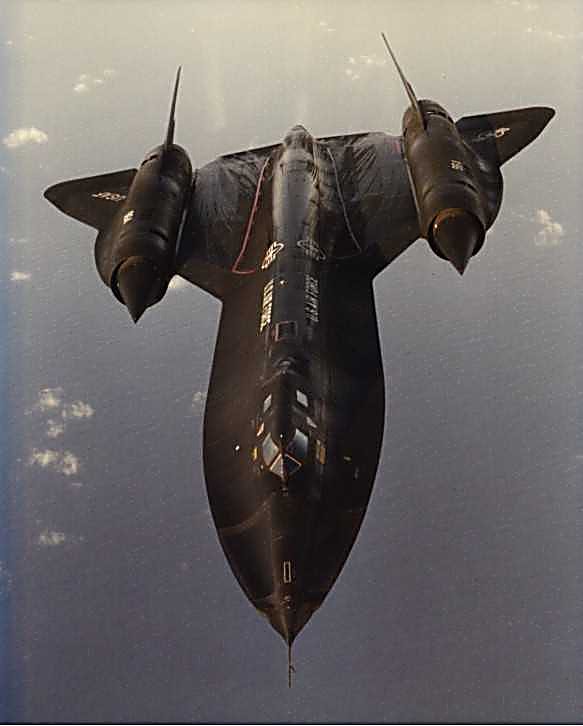
Walt continues to update mewith numerous reactions he sees on the DEF panel. He is receiving missle tracking signals. With each mile we traverse, every two seconds, I become more uncomfortable driving deeper into this barren and hostile land.
I am glag the DEF panel is not in the front seat. It would be a big distraction now, seeing the lights flashing. In contrast my cockpit is "quiet" as the jet purrs and relishes her new-found strength, continuing to slowly accelerate. The spikes are full aft now, tucked twenty-six inches deep into the nacelles. With all inlet doors tightly shut, at 3.24 Mach, the J-58's are more like ramjets now, gulping 100,000 cubic feet of air per second. We are a roaring express now, and as we roll through the enemy's backyard, I hope our speed continues to defeat the missle radars below.
We are approaching a turn, and this is good. It will only make it more difficult for any launched missle to solve the solutionfor hitting our aircraft. I push the speed up at Walt's request. The jet does not skip a beat, nothing fluctuates, and the cameras have a rock steady platform.
Walt receives missile launch signals. Before he can say anthing else, my left hand instinctively moves the throttles yet further forward. My eyes to the temperature guages now, as I know the jet willingly go to speeds that will harm her. The tekps are relatively cool and from all the warm temps we've encountered thus far, this surprises me...but then, it really doesn't surprise me. Mach 3.31 and Walt are quiet for the moment.
I move my gloved finger across the small silver wheel on the autopilot which controls the aircraft's pitch. With the deft feel known to Swiss watchmakers, surgeons, and "dinosaurs" [old-time pilots who not only fly airplanes but "feel it"] I rotate the pitch wheel somewhere between one-sixteenth and one-eighth of an inch, locating a position which yields the 500-foot-per-minute climb I desire. The jet raises her nose one-sixth of a degree and knows I'll push higher as she goes faster. The Mach continues to rise, but during this segment of our route, Iam in no mood to pull the throttles back.
Walt's voice pierces the quiet of my cockpit with the news of more missile launch signals. The gravity of Walt's voice tells me that he believes the signals to be a more valid threat than the others. Within seconds he tells me to "push it up" and I firmly press both throttles against thier stops. For the next few seconds I let the jet go as fast as she wants.
A final turn is coming up and we both know that if we can hit that turn at this speed, we most likely will defeat any missles. We are not there yet, though, and I am wondering if Walt will call for a defensive turn off our course. With no words spoken, I sense Walter is thinking in concert with me about maintaining our programmed course.
To keep from worrying, I glance outside, wondering if I'll be able to visually pick up a missle aimed at us. Odd are the thoughts that wander through one's mindin times like these.I found myself recalling the words of former SR-71 pilotrs who were fired upon while flying missions in North Vietnam. They said the few errant missle detonations they wer able to observe from the cockpit looked like implosions rather than explosions.This was due to the great speed at the jet was hurling away from the exploding missle. I see nothing outside except the endless expanse of a steel blue sky and the broad patch of tan earth below.
I have only had my eyes out of the cockpit for seconds, but it seems like many minutes since I have last checked the guages inside. Returning my attention inward, I glance at the miles counter teling one how many to go until we can start our turn. Then I note the Mach, and passing beyond 3.45, I realize that Walter and I have attained new personel records. The Mach continues to increase. The ride is incredibly smooth.
There seems to be a confirmed trust now, between me and the jet; she will not hesitat to deliver whatever speed we need, and I can count on no problems from the inlets. Walt and I are ultimately depending on the jet now-more so than normal-and she seems to know it. The cooler outside temperatures hav awakened the spirit born into her years ago, when men dedicated to excellence took the time to build her well. Wioth spikes and doors as tight as they can get we are racing against the time it would take a missile to reach our altitude. it is a race this jet will not let us lose. The Mach eases to 3.5 as we crest 80,000 feet. We are a bullet now-except faster.
We hit the turn, and I feel some relief as our nose swings away from a country we have seen quite enough of. Screaming past Tripoli, our phenomonal speed continues to rise, and the screaming sled pummels the enemy one more time, laying down a parting sonic boom.
In seconds, we see nothing but the expansive blue of the Mediterranean. I realize that I still have my left hand full-forward and we are continuing to rocket along in maximum afterburner. The TDI now shows us Mach numbers not only new to our experience but flat out scary. Walt says the DEF panel is now quiet and I know it is time toreduce our incredible speed . I pull the throttles to min 'burner range and the jet still doesn't want to slow down. Normally, the Mach would be affected immediately when making such a large throttle movement. But for a few moments, old 960 just sat out there at the high Mach she seemed to love and, like the proud sled she was, only began to slow when we were well out of danger. I loved that jet.


As a former SR-71 pilot, and a professional keynote speaker, the question I'm most often asked is "How fast would the SR-71 fly?" I can be assured of hearing that question several times at any event I attend. It's an interesting question, given the aircraft's proclivity for speed, but there really isn't one number to give, as the jet would always give you a little more speed if you wanted it to. It was common to see 35 miles a minute (2100 mph). Because we flew a programmed Mach number on most missions, and never wanted to harm the plane in any way, we never let it run out to any limits of temperature or speed. I saw mine over Libya when Khadafy fired two missles my way, and max power was in order (see article above). Let's just say that the plane truly loved speed and effortlessly took us to Mach numbers we hadn't previously seen.
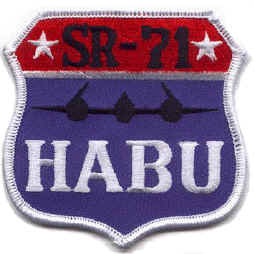
So it was with great surprise, when at the end of one of my presentations , someone asked, "what was the slowest you ever flew the Blackbird?" That was a first. After giving it some thought, I was reminded of a story that I had never shared before, and relayed the following. I was flying the SR-71 out of RAF Mildenhall, England, with my back-seater, Walt Watson; we were returning from a mission over Europe and the Iron Curtain when we received a radio transmission from home base. As we scooted across Denmark in three minutes, we learned that a small RAF base in the English countryside had requested an SR-71 fly-past. The air cadet commander there was a former Blackbird pilot, and thought it would be a motivating moment for the young lads to see the mighty SR-71 perform a low approach. No problem, we were happy to do it. After a quick aerial refueling over the North Sea, we proceeded to find the small airfield.
Walter had a myriad of sophisticated navigation equipment in the back seat, and began to vector me toward the field. Descending to subsonic speeds, we found ourselves over a densely wooded area in a slight haze. Like most former WWII British airfields, the one we were looking for had a small tower and little surrounding infrastructure. Walter told me we were close and that I should be able to see the field, but I saw nothing.
Nothing but trees as far as I could see in the haze. We got a little lower, and I pulled the throttles back from 325 knots we were at. With gear up, anything under 275 was just uncomfortable. Walt said we were practically over the field - yet; there was nothing in my windscreen. I banked the jet and started a gentle circling maneuver in hopes of picking up anything that looked like a field. Meanwhile , below, the cadet commander had taken the cadets up on the catwalk of the tower in order to get a prime view of the fly-past. I was a quiet, still day with no wind and partial gray overcast.
Walter continued to give me indications that the field should be below us but in the overcast and haze , I couldn't see it. The longer we continued to peer out the window and circle, the slower we got. With our power back, the awaiting cadets heard nothing. I must have had good instructors in my flying career, as something told me I had better cross-check the guages. As I noticed the the airspeed indicator slide below 160 knots, my heart stopped and my adrealin-filled left hand pushed two throttles full forward. At this point we weren't really flying, but were falling in a slight bank. Just at that moment that both afterburners lit with a thunderous roar of flame (and what a joyous feeling that was) the aircraft fell in full view of the shocked observers on the tower. Shattering the still quiet of that morning, they now had 107 feet of fire-breathing titanium in their face as the plane leveled and accelerated, in full burner, on the tower side of the infield, closer than expected, maintaining what could only be described as some sort of ultimate knife-edge pass.
Quickly reaching the field boundry, we proceeded back to Mildenhall without incident. We didn't say a word for those next 14 minutes.
After landing , our commander greeted us, and we were both certain he was reaching for our wings. Instead, he heartily shook our hands and said the commander had told him it was the greatest SR-71 fly-past he had ever seen, especially how we had surprised them with such a precise maneuver that could only be described as breathtaking. He said that some of the cadets hats were blown off and the sight of the planform of the plane in full afterburner dropping right in front of them was unbelievable. Walt and I both understood the concept of "breathtaking" very well that morning, and sheepishly replied that they were just excited to see our low approach.
As we retired to the equipment room to change from space suits to flight suits, we just sat there - we hadn't spoken a word since "the pass." Finally, Walt looked at me and said, "One-hundred and sixty knots. What did you see?" Trying to find my voice , I stammered , "One-hundred fifty-two." We sat in silence for a moment. Then walt said, "Don't ever do that to me again!" And I never did.
A year later, Walter and I were having lunch in the Mildenhall Officer's club, and overheard an officer talking to some cadets about an SR-71 fly-past that he had seen one day. Of course, by now the story included kids falling off the tower and screaming as the heat of the jet singed their eyebrows. Noticing our HABU patches, as we stood there with lunch trays in our hands, he asked us to verify trade show giveaways to the cadets that such a thing occurred. Walt just shook his head and said, "It was probably just a routine low approach, they're pretty impressive in that plane." Impressive indeed.
Little did I realize after relaying this experience to my audience that day that it would become one of the most popular and most requested stories. It's ironic that people are interested in how slow the worlds fastest jet can fly. Regardless of your speed, however, it's always a good idea to keep that cross-check up, and keep your Mach up, too.
